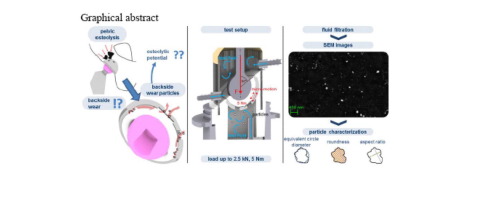当前位置:
X-MOL 学术
›
Acta Biomater.
›
论文详情
Our official English website, www.x-mol.net, welcomes your feedback! (Note: you will need to create a separate account there.)
Backside wear in acetabular hip joint replacement.
Acta Biomaterialia ( IF 9.7 ) Pub Date : 2018-11-05 , DOI: 10.1016/j.actbio.2018.10.045 Steffen Braun 1 , Robert Sonntag 1 , Stefan Schroeder 1 , Ulrike Mueller 1 , Sebastian Jaeger 1 , Tobias Gotterbarm 2 , Jan Philippe Kretzer 1
Acta Biomaterialia ( IF 9.7 ) Pub Date : 2018-11-05 , DOI: 10.1016/j.actbio.2018.10.045 Steffen Braun 1 , Robert Sonntag 1 , Stefan Schroeder 1 , Ulrike Mueller 1 , Sebastian Jaeger 1 , Tobias Gotterbarm 2 , Jan Philippe Kretzer 1
Affiliation

|
INTRODUCTION
Besides head-insert articulation in hip joint replacements, micro-motions between the backside of assembled polyethylene acetabular liners and the metal cup may cause additional wear. Pelvic osteolysis frequently occurs in the region of screw holes, and cup loosening hints to clinically relevant amounts of polyethylene backside wear. It has yet to be confirmed whether backside wear particles differ in size and morphology compared to articulating wear. Previous methods have been limited to subjective assessment of backside surface damages without consideration of wear debris. The aim of this study was to develop and validate a method for quantitative in vitro measurements of polyethylene backside wear in artificial hip cups and to characterize these wear particles for the first time.
METHODS
Titanium cup-systems (Plasmafit®Plus7, Aesculap, UHMWPE liner) were sinusoidally loaded (2.5 kN) and a torque of 5 Nm was simultaneously applied. The front and rear side of the cup were separated to isolate backside wear. After 2 × 106 cycles the surrounding fluid was filtered and a particle analysis was performed.
RESULTS
Backside wear had a particles size of 64.1 ± 1.9 nm and was verified as round and oval particles with partly rough outlines. An estimated total number of particles of 1.26 × 109 ± 1.67 × 108 per 106 cycles was determined.
CONCLUSION
Backside wear was estimated to be several times lower than published values of articulating wear. However, polyethylene backside wear particles represented significantly smaller particles with partly roughened outlines than articulating wear particles and may therefore cause higher biological response in macrophage-mediated bone resorption compared to articulated particles.
STATEMENT OF SIGNIFICANCE
Within this study, an analytical method for quantitative measuring polyethylene backside wear of artificial hip cups was successfully developed and validated for the first time. It could be shown that backside wear is still present, even in modern cup-systems. These findings can be further used for investigations of the osteolytic potential of polyethylene particles, for evaluating and improving new implant systems and to evaluate the effectiveness of screw hole plugs to prevent the particle migration to the acetabulum.
中文翻译:

髋臼髋关节置换术的背面磨损。
简介除了髋关节置换术中的头插入式关节运动以外,组装的聚乙烯髋臼内衬背面与金属杯之间的微小运动可能会导致额外的磨损。骨盆骨溶解经常发生在螺丝孔区域,并且杯体松动提示临床上与聚乙烯背侧磨损相关的量。与铰接式磨损相比,背面磨损颗粒的尺寸和形态是否不同尚待确认。先前的方法仅限于主观评估背面表面损坏,而不考虑磨损碎片。这项研究的目的是开发和验证一种用于定量测量人造髋关节杯中聚乙烯背面磨损的体外方法,并首次表征这些磨损颗粒。方法钛杯系统(Plasmafit®Plus7,将Aesculap,UHMWPE衬里)进行正弦加载(2.5 kN),并同时施加5 Nm的扭矩。杯子的前侧和后侧分开以隔离后侧磨损。经过2×106个循环后,将周围的流体过滤并进行了颗粒分析。结果背面磨损的颗粒尺寸为64.1±1.9 nm,并且被验证为圆形和椭圆形的颗粒,轮廓部分粗糙。每106个循环的估计粒子总数为1.26×109±1.67×108。结论背面磨损估计比关节磨损的公布值低几倍。然而,聚乙烯背面磨损颗粒比铰接磨损颗粒代表明显更小的颗粒,轮廓部分粗糙化,因此与铰接颗粒相比,巨噬细胞介导的骨吸收可引起更高的生物学反应。重要性说明在这项研究中,成功开发出了一种用于定量测量人造髋关节杯的聚乙烯背面磨损的分析方法,并首次得到了验证。可以证明,即使在现代杯子系统中,背面磨损仍然存在。这些发现可进一步用于研究聚乙烯颗粒的溶骨潜力,评估和改进新的植入系统以及评估螺孔塞防止颗粒迁移至髋臼的有效性。
更新日期:2018-11-06
中文翻译:

髋臼髋关节置换术的背面磨损。
简介除了髋关节置换术中的头插入式关节运动以外,组装的聚乙烯髋臼内衬背面与金属杯之间的微小运动可能会导致额外的磨损。骨盆骨溶解经常发生在螺丝孔区域,并且杯体松动提示临床上与聚乙烯背侧磨损相关的量。与铰接式磨损相比,背面磨损颗粒的尺寸和形态是否不同尚待确认。先前的方法仅限于主观评估背面表面损坏,而不考虑磨损碎片。这项研究的目的是开发和验证一种用于定量测量人造髋关节杯中聚乙烯背面磨损的体外方法,并首次表征这些磨损颗粒。方法钛杯系统(Plasmafit®Plus7,将Aesculap,UHMWPE衬里)进行正弦加载(2.5 kN),并同时施加5 Nm的扭矩。杯子的前侧和后侧分开以隔离后侧磨损。经过2×106个循环后,将周围的流体过滤并进行了颗粒分析。结果背面磨损的颗粒尺寸为64.1±1.9 nm,并且被验证为圆形和椭圆形的颗粒,轮廓部分粗糙。每106个循环的估计粒子总数为1.26×109±1.67×108。结论背面磨损估计比关节磨损的公布值低几倍。然而,聚乙烯背面磨损颗粒比铰接磨损颗粒代表明显更小的颗粒,轮廓部分粗糙化,因此与铰接颗粒相比,巨噬细胞介导的骨吸收可引起更高的生物学反应。重要性说明在这项研究中,成功开发出了一种用于定量测量人造髋关节杯的聚乙烯背面磨损的分析方法,并首次得到了验证。可以证明,即使在现代杯子系统中,背面磨损仍然存在。这些发现可进一步用于研究聚乙烯颗粒的溶骨潜力,评估和改进新的植入系统以及评估螺孔塞防止颗粒迁移至髋臼的有效性。


























 京公网安备 11010802027423号
京公网安备 11010802027423号